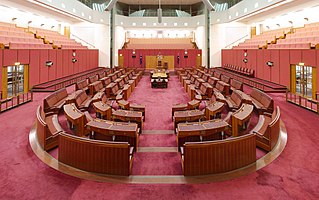
James Merrill Jeffords was an American politician who served as a U.S. Senator from Vermont. Sworn into the Senate in 1989, he served as a Republican until 2001, when he left the party to become an independent and began caucusing with the Democrats. Jeffords retired from the Senate in 2007. Prior to serving in the Senate, he served as the U.S. Representative for Vermont's at-large congressional district from 1975 to 1989.

Ben Nighthorse Campbell is a Cheyenne-American politician who served as a U.S. Representative from 1987 to 1993, and a U.S. Senator from Colorado from 1993 to 2005. He serves as one of forty-four members of the Council of Chiefs of the Northern Cheyenne Indian Tribe. During his time in office, he was the only American Indian serving in the U.S. Congress.

Arlen Specter was an American lawyer, author, and politician who served as United States Senator for Pennsylvania. Specter was a Democrat from 1951 to 1965, then a Republican from 1965 until 2009, when he switched back to the Democratic Party. First elected in 1980, he represented Pennsylvania in the U.S. Senate for 30 years.

The Arizona Senate is part of the Arizona Legislature, the state legislature of the US state of Arizona. The Senate consists of 30 members each representing an average of 219,859 constituents. Members serve two-year terms with term limits that limit Senators to four terms for a total of eight years. Members of the Republican Party are currently the majority in the Senate.
United States senators are conventionally ranked by the length of their tenure in the Senate. The senator in each U.S. state with the longer time in office is known as the senior senator; the other is the junior senator. This convention has no official standing, though seniority confers several benefits, including preference in the choice of committee assignments and physical offices. When senators have been in office for the same length of time, a number of tiebreakers, including previous offices held, are used to determine seniority.

The Iowa Senate is the upper house of the Iowa General Assembly, United States. There are 50 seats in the Iowa Senate, representing 50 single-member districts across the state of Iowa with populations of approximately 60,927 per constituency, as of the 2010 United States Census. Each Senate district is composed of two House districts. The Senate meets at the Iowa State Capitol in Des Moines.

Party divisions of United States Congresses have played a central role in the organization and operations of both chambers of the United States Congress—the Senate and the House of Representatives—since its establishment as the bicameral legislature of the Federal government of the United States in 1789. Political parties had not been anticipated when the U.S. Constitution was drafted in 1787, nor did they exist at the time the first Senate elections and House elections occurred in 1788 and 1789. Organized political parties developed in the U.S. in the 1790s, but political factions—from which organized parties evolved—began to appear almost immediately after the 1st Congress convened. Those who supported the Washington administration were referred to as "pro-administration" and would eventually form the Federalist Party, while those in opposition joined the emerging Democratic-Republican Party.

The 1966 South Carolina United States Senate election was held on November 8, 1966 to select the U.S. Senator from the state of South Carolina simultaneously with the special election to fill out the remainder of Olin D. Johnston's term. Incumbent Senator Strom Thurmond, who had switched parties from Democratic to Republican in 1964, easily defeated state senator Bradley Morrah in the general election.
The following table indicates the parties of elected officials in the U.S. state of Alaska:

The 2010 United States Senate election in Alabama took place on November 2, 2010 alongside other elections to the United States Senate in other states, as well as elections to the United States House of Representatives and various state and local elections. Incumbent Republican United States Senator Richard Shelby won re-election to a fifth term.

The 2020 United States elections will be held on Tuesday, November 3, 2020. All 435 seats in the United States House of Representatives, 34 of the 100 seats in the United States Senate, and the office of president of the United States will be contested. Thirteen state and territorial governorships, as well as numerous other state and local elections, will also be contested.










